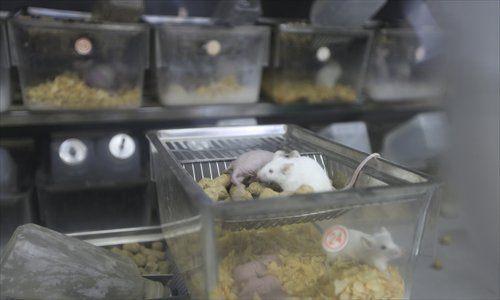

An isolation room of the Shanghai Laboratory Animals Center Photo: Wang Zhefeng/GT
In a quiet yard in Shanghai's Songjiang district stands a memorial for laboratory animals with a plaque reading: "Dedicated to the memory of laboratory animals."
This memorial is tucked away in the Shanghai Laboratory Animals Center (SLAC) at the Shanghai Institutes for Biological Sciences (SIBS) under the Chinese Academy of Sciences (CAS).
Today mice are the most commonly used animals for testing in laboratories. They are vertebrates, reproduce rapidly and share 99 percent of their genes with humans.
In the 20th century it became obvious that standards for laboratory test mice and rats had to be established, and leading research institutions like the Jackson Laboratory set these standards which were universally accepted.
China was a late starter in modern biological research and animal testing and, at first, it imported test animals for research. But in 1982, the CAS, China's leading research body, established three designated laboratory animal centers and the Shanghai Laboratory Animals Center was one of these.
Every Monday, Wednesday and Friday, a specially modified vehicle transports thousands of mice and rats to the Hutchison Medi Pharma in Pudong New Area. Hutchison is a drug research and development company and the scientists there need thousands of mice to continue their research.

The memorial at the center Photo: Wang Zhefeng/GT
Cancer treatment
Lu Yuqi is the operations manager of Hutchison's laboratory animal center and told the Global Times his company developed new drugs to treat cancer and immunity problems. "After we develop a new drug we have to transplant a specific cancer to mice and treat them with the drug to test whether it is effective on living animals and to gauge its toxicity.
"This is how we work. Every stage of development of a new drug must be first tested on animals before being tested on humans."
Mi Wenli is an assistant professor at School of Basic Medical Sciences with Fudan University and she is currently doing research in the US. As a young research fellow who has been studying integrative medicine and neurobiology for the past 10 years, she has done many experiments with mice.
"We purchase different sorts of mice for different testing." Mice that have been genetically modified in certain ways are used for different experiments and tests.
Mi believes that the quality of the test mice plays an important role in the experiments. "We need to have certainty for every test - if there are subtle differences in the mice we use, this can affect the results." This is one reason why her laboratory buys mice from SLAC.
"In China the quality of their laboratory mice is second to none. And they are very experienced in producing laboratory mice. Sometimes we buy genetically modified mice from abroad and let SLAC help us raise them," Mi said. Certain types of mice are in such demand that often her laboratory has to pay a cash deposit in advance.
SLAC was originally founded in 1965. It was designated one of the country's three laboratory animal centers in 1982 and in 1992, it became the National Rodent Laboratory Animal Resources, Shanghai branch. Every year, about 1.5 million laboratory animals are produced here.
When the Global Times walked into the building where the animals are kept the first overwhelming impression was the smell. Alongside Bao Shimin, the management representative for the center, the Global Times reporter donned a cap, gown and respirator to look over the facility.
"Although the smell is bad, these animals are quite clean," Bao said. He explained that the animals were kept in different levels of environmental cleanliness. "The ordinary animals are kept in a room with an atmosphere of 10,000 dust particles per cubic meter (an ordinary outside urban atmosphere has 35 million particles per cubic meter). Some of the animals are kept in a special clean room with just 100 dust particles per cubic meter and they are completely sterile." Access to the clean room involves air locks, showers, special protective clothing and footwear.
In the basic laboratory animal room there are rows and rows of isolation containers where the animals are kept in different layers according to type and age. They have cages with wood shavings on the bottom and containers of food and water.

Laboratory animal breeding records Photo: Wang Zhefeng/GT
Constant temperature
"The containers maintain constant temperature and humidity. The air inside the containers has been filtered three times and all of the food, water and wood chips have been sterilized," Bao said.
He said currently the center was earning 60 million yuan ($9.80 million) a year, accounting for between 70 to 80 percent of the market in Shanghai and up to 13 percent of the market in China. The prices of the laboratory animals were set depending on demand, the difficulties in breeding and raising and resources required.
"We have a big price range. A laboratory mouse can cost from 10 yuan to 1,000 yuan. The mice that have been modified to contract human diseases like hypertension or lupus cost about 600 yuan but the most expensive are the sterile mice."
Bao said the bestsellers were NOD-SCID and Nude mice which are used in cancer research. "We have five major species of laboratory animals - mice, rats, shrews, guinea pigs and rabbits with more than 70 strains of different classified types."
Bao said the center had two types of clients: authorized animal breeding organizations like provincial laboratory animal centers that periodically needed to compare national standards and authorized research organizations like universities, hospitals, pharmaceutical plants and contract research companies.
"We sell our animals as far north as Heilongjiang Province, as far west as Xinjiang Uyghur Autonomous Region and as far as south as Hainan Province," Bao said. He recalled the very early days of the center in the 1980s where he would fly, sitting in a passenger seat with a cage of mice on his knee. "That won't happen again."
Ma Shirong is the manager of the Shanghai Jiazhen Freight Co, Ltd which transports live animals. He told the Global Times that as long as there is a quarantine certificate, he can arrange a flight to transport animals anywhere. They have to be kept in a hyperbaric oxygen chamber, he said.
In the animal isolation rooms, staff wear green protective suits and respirators as they clean the cages. They have grown used to the smell of ammonia and disinfectant.

Mice in an isolation container Photo: Wang Zhefeng/GT
Quite cute
Li Xingchun is the administrator of the rodent room - the 26-year-old has been working here for four years. His daily task is to care for the more than 1,000 rodents here. "They're quite cute. When rats go to sleep they lie on their backs with their hands and feet in the air. They look like polar bears."
He thinks that his rats and mice are sensitive creatures. If they are handled by strangers, for example, they will not cooperate readily and can make tests difficult. But if he or his staff handle them they will sit quietly in their hands.
Gao Jinghua is a senior technician at the center and she felt that looking after the animals was a bit like looking after children. Whenever she goes to the guinea pig room they squeak happily at her knowing they will be fed. But if a stranger comes in they look frightened and panic.
Although both Li and Gao like the animals they understand clearly that their little friends are destined for research purposes.
Liao Kan is the director of the center and a professor of biology at the Shanghai Institutes for Biological Sciences. He believes these laboratory animals are an important base for exploring life science and as a bridge between science and clinics. "If we didn't do animal testing, our biomedical research would remain at a cellular research stage and we would never have a proper understanding of how things worked or how a compound would function in a living entity."
Liao emphasized that animal testing was an advanced stage of biomedical research and was only undertaken when research at the cellular stages had been completed. It was only carried out when preceding-related research in the cellular stage had been successfully completed and only authorized institutions could use animals in experiments.
"In China every municipality, province or autonomous region has an animal management committee and any institution that wants to do animal testing needs to get permission. Authorized institutions have to establish animal ethics committees to carry out internal verification and ensure that the numbers of animals involved and the methodology is reasonable."
A responsibility
"Private individuals can never buy laboratory animals from the center. Every year, China uses 20 million laboratory animals and their lives have to be respected by men. All scientists have a responsibility to be kind to laboratory animals and treat their animals ethically."
Most animals are only used once for experimental work and then they are euthanized. On Tomb-sweeping Day, it's common to see laboratory staff lay flowers at the center's animal memorial.
There are problems with the current specifications that govern laboratory animals. "In the West there are associations or societies that can reform the testing standards and it is easier for them to modify the specifications they work under," Liao said.
"But in China, the standards are regulated by the Ministry of Science and Technology. This inevitably delays the response to new findings in laboratory animal research. It can take several years to change or modify the standards."
The current standards were first established in 1994 and revised in 2010. Although international standards have changed considerably in that time Chinese institutions have to continue working under their old versions.
"The people involved in laboratory animal work in China want to change the standards regularly, but the governing system responds slowly," Liao said. (Global Times)

86-10-68597521 (day)
86-10-68597289 (night)

86-10-68511095 (day)
86-10-68512458 (night)

cas_en@cas.cn

52 Sanlihe Rd., Xicheng District,
Beijing, China (100864)

